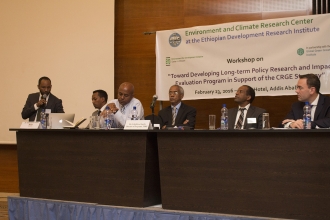EfD Policy Research Review Workshop
Representatives from all EfD centers meet to discuss and present their centers Research Policy Review plans
Representatives from all EfD centers meet to discuss and present their centers Research Policy Review plans

Toward Developing Long-term Policy Research and Impact Evaluation Program in Support of the CRGE
Recent literature on constraints to adoption of clean cookstoves points out liquidity and access to credit as the key factors explaining the low adoption rate of modern cooking appli-ances in
Use of biomass fuels such as charcoal has been documented to be a prime cause of deforestation and environmental degradation in developing countries. Yet there are low rates of adoption to more

EfD Research Director, Dr. Yonas Alem represented the EfD initiative at the International Growth Center’s Energy and Growth conference held in London, Nov 12-13, 2015. The conference brought academics…
We use county-level data on crop yields and cropland to estimate the potential biomass supply from crop residues in China. We find that China can potentially produce about 250 million dry metric tons of crop residues per year when biomass prices are greater than $100 per metric ton. We also find that rice straw is expected to account for about 47% of total residue production, while corn stover (residue) can contribute 28% to total biomass production in China and wheat straw can contribute 25%.
This thesis consists of three self-contained chapters on issues related to spillover effects of behavioral and policy interventions aimed at reducing negative incentives provided by consumption and production subsidies, and discusses the implications for environmental policy design. The first two chapters investigate spillover effects of a behavioral intervention aimed at incentivizing residential water savings in Colombia.
The specific objectives of study include, a review of literature on energy demand, choice and distributional effects of energy fuel taxes in Kenya; examine the current demand for energy and determine
Make wind and solar power even cheaper by opening up access to the electricity gridand ending fossil-fuel subsidies, urge Gernot Wagner and colleagues. Putting a price on carbon dioxide and other greenhouse gases to curb emissions must be the centrepiece of any comprehensive climate-change policy. We know it works: pricing carbon creates broad incentives to cut emissions. Yet the current price of carbon remains much too low relative to the hidden environmental, health and societal costs of burning a tonne of coal or a barrel of oil.
Although Kenya enjoys a high and widespread daily solar insolation, and despite enactment of policies to promote adoption of renewable energy technologies, not many households have picked up solar technologies. The objective of this study is to find out the incidence and predictors of actual up-take of solar technology as well as households’ desire to switch to solar in light of their perception of its cost advantage.